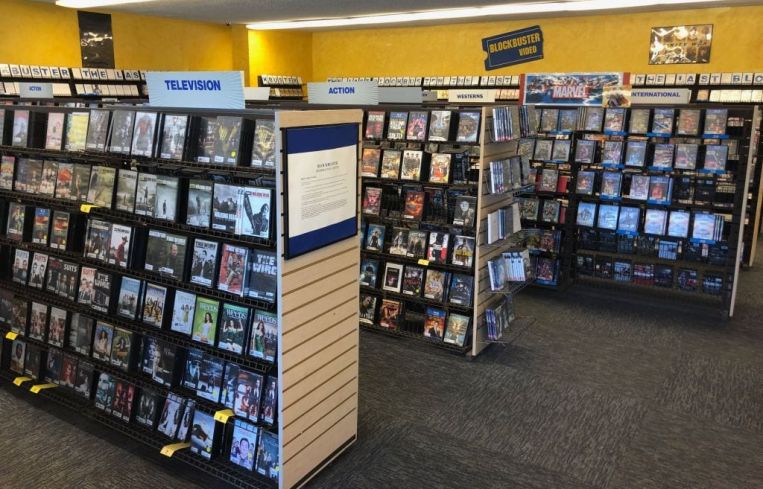Netflix Documentary ‘The Last Blockbuster’ Is a Nostalgic Farewell to 90s Icon
By Chava Gourarie April 1, 2021 9:34 am
reprints
The last Blockbuster in the world is in a strip mall in Bend, Ore., next to a take-and-bake pizza shop.
It is a monument where people come to relive their teenage years and recall the hours they spent browsing the aisles of their local Blockbuster, surrounded by blue and yellow with the smell of plastic and VHS tapes wafting in the air while other customers did the same.
They came from all over the world, to this alternate universe, where they can see, smell and experience the past. In a way, the last Blockbuster’s existence, almost as a museum, cements the fact that the way of life it represents is truly gone.
That is the message of “The Last Blockbuster,” a documentary now streaming on Netflix about the lone holdout still bearing the Blockbuster name. Heavy on nostalgia, the film splits most of its time between following Sandi Harding, the affable general manager at the Bend store, and mining the nostalgia of actors, Blockbuster lovers and movie buffs.
It also tells the story of Blockbuster’s arc from local video store to cultural staple to circus act, marking the lifespan of an entire economy erased by the internet: the selling of physical copies of movies.
It’s an easy story to tell by the number of Blockbuster stores. In 1985, David Cook opened the first Blockbuster in Dallas, Texas, when movie studios were selling VHS tapes for $99 a pop. Blockbuster distinguished itself from other local video stores by staying open until midnight, nixing the adult section, displaying the movies on the shelves and, crucially, running its inventory on software rather than paper logs. (The first Blockbuster is now an Applebee’s.)
A year later, there were 20 locations. By 1994, there were 3,600 stores and Blockbuster was an immutable fact of 1990s culture. That’s when Viacom purchased it for $8.3 billion. At its peak a decade later — now a public company saddled with debt and threatened by the internet — there were 9,000 locations.
In 2010, when it filed for bankruptcy, there were 3,000 locations. In 2014, corporate closed for good, leaving just 50 franchise locations. In 2017, there were 12 left. In 2018, four. And, in 2019, just one.
The one in Bend.
In the 90s, Ken and Debbie Tisher moved to Bend from California, and spent their entire $400,000 life savings to open a video rental store named Pacific Video. They had three locations in 1998 when Blockbuster signed a revenue sharing agreement with the studios that killed most independent stores. So, Pacific Video became a Blockbuster franchise. And, while other Blockbusters dropped like flies, the Bend location remained.
“The Last Blockbuster” makes a half-hearted attempt to make the case that Blockbuster’s end wasn’t inevitable, by including an interview with former Blockbuster chief financial officer Tom Casey, who said that Blockbuster was poised for a comeback, but it was a combination of previous bad financial decisions and the unfortunate timing of the Great Recession that undid the video rental empire.
Both Netflix and Blockbuster were poised for growth, Casey said, but what happened next was simple. “They had capital, we did not.”
Maybe. But even if had Blockbuster survived, it would not be the video rental store it was, and there would still be a documentary to make about the death of the Blockbuster-and-pizza date.
There would still be millions of millennials and Generation Xers — including actor Paul Scheer, filmmaker Kevin Smith, comedian Ron Funches and local Bend film critic Jared Rasic — to interview about the joys of the video store experience: hearing the satisfying click when you close the VHS box, perusing the shelf with the employee picks, choosing a movie to not watch with your girlfriend.
There would still be a sense of loss over an experience that is not coming back.
In the end, what makes Bend different is probably Harding, who calls herself a “Blockbuster Mom,” and who has run the store since the early 2000s. She has employed her children, her extended family and half the teenagers in Bend, and treats them all like family. She knows her customers by name, shops for new releases in Target and candy in Costco, knits blue and yellow winter hats by hand, and fixes the ancient computer system by herself by scavenging for obsolete parts.
The last Blockbuster on Earth went back to its origins as an independent, mom-and-pop shop, where people come as much to rent a movie as for the sense of community.
Dish Network, which now owns the Blockbuster trademark, has renewed the shop’s license to use the Blockbuster name for another term. So, for now, there’s nothing to stop the store from staying open (even during the pandemic), except, of course, for one important thing.
“What will it take to keep the store open indefinitely?” the interviewer asked Ken Tisher.
“Customers,” he said.


